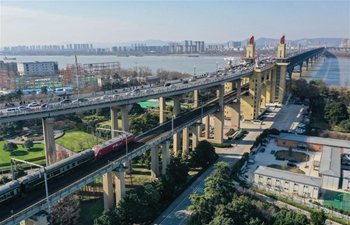BEIJING, Dec. 31 (Xinhua) -- China's economy has defied doom-mongers again in 2018, and economists believe there are good reasons to remain confident about its outlook.
Although latest economic indicators revealed signs of stress, as industrial profits posted their first drop in three years and consumption growth missed expectations in November, merely focusing on short-term fluctuations will miss the big picture of the economy.
China's tone-setting economic meeting described problems facing the economy as part of development, noting that the country is still and will be in an important period of strategic opportunity for development for a long time to come.
SOUND FUNDAMENTALS
Despite downward pressure from the Sino-U.S. trade frictions, a rebalancing and deleveraging domestic economy and monetary tightening in certain developed economies, China has maintained stable economic growth, offering certainties to a world mired in uncertainties.
Its GDP rose 6.7 percent in the first three quarters of 2018, putting the economy on track to meet the government's targeted growth of around 6.5 percent set for 2018.
Niu Li, an economist with the State Information Center, a government think tank, said the economy is highly likely to rise 6.6 percent this year.
This means China remains a top performer in the global economic arena, with the IMF forecasting growth of 2.4 percent for advanced economies this year.
The Sino-U.S. trade frictions have been properly dealt with. Employment remains stable, consumer inflation is kept at a mild level, resident income continues to grow steadily, while development is more balanced and sustainable with higher quality.
Consumption is set to contribute 78.2 percent of China's economic growth this year, the highest level since 2001, according to a report released by the Chinese Academy of Social Sciences this month.
"We expect consumption to remain the largest driver of the economy in the next decade," said Ding Shuang, an economist of the Standard Chartered Bank, citing great potential consumption to continue to grow faster than investment amid the ongoing trends of urbanization, aging and a rising middle-income group that demands quality goods and services.
While consumer spending contributed a bigger share of GDP growth, technology and innovation are picking up the slack as certain traditional industries took a hit.
High-tech manufacturing and equipment production sectors maintained fast expansion. In the Global Innovation Index 2018 by the World Intellectual Property Organization, China became the first middle-income economy on the list of the world's 20 most innovative economies this year.
The medium-high level of growth achieved during the past year exhibited the vitality and resilience of the Chinese economy, which will ensure its future stability, said Liu Qiao, head of the Guanghua School of Management at Peking University.
ENOUGH AMMUNITION
Another reason for the optimism is that the Chinese policymakers have many economic levers at hand to deal with challenges, analysts said.
The government's options include supply-side structural reform, credit policy, and fiscal firepower.
On the monetary policy front, economists said broad-based easing is not immediately on the cards, but the central bank may tweak policies to keep funding flowing to the backbone of the economy without funneling credit to companies that are already highly indebted.
The Standard Chartered Bank said the People's Bank of China might cut the reserve requirement ratio by 200 basis points by the end of 2019 to prevent a tightening of monetary and credit conditions and reduce funding costs for the real economy by providing banks with long-term liquidity at a relatively low cost.
China's stable economic growth enables a more proactive fiscal policy through deeper tax and fee cuts as well as accelerating government spending.
UBS economist Wang Tao expected the fiscal budget deficit to rise to 3 percent of GDP in 2019 from 2.6 percent in 2018, and tax cuts to exceed one percent of GDP, mainly in value-added tax, corporate income tax, and individual income tax, together with a reduction in corporate social insurance contribution.
To boost government spending, the country's legislature has adopted a decision to speed up local government bond issuance before the approval of the annual fiscal budget.
Between Jan. 1, 2019 and Dec. 31, 2022, the State Council will be authorized to assign part of the newly-added quotas for local government bonds each year before the annual budget approval.
Yang Weimin, deputy director of the economic committee of the Chinese People's Political Consultative Conference National Committee, said the country should also further supply-side structural reform to fix the mismatch in resource allocation to enhance economic resilience.
Previous structural adjustments should be reinforced, with continued efforts to downsize glutted industries, reduce all types of business burdens and channel more energy into weak areas including infrastructure, according to the annual Central Economic Work Conference.
FASTER REFORM, WIDER OPENING-UP
This year marked the 40th anniversary of its reform and opening-up, which China commemorated with concrete moves to overhaul and reform its economy.
The country has broadened market access, reduced import duties, built new ground in opening up and provided new platforms for win-win cooperation with the rest of the world.
Foreign ownership restrictions in the financial and auto sectors have been eased, with some ownership caps to be removed completely in the coming three years; tariffs were cut for an array of imported products including cars, consumer products, and industrial goods; and more import duty cuts will come into effect next year.
Reform and opening-up has gained pace. In its latest step, China announced on Dec. 25 a negative list for market access that is shorter and applies to all market players, allowing them to equally enter sectors that are not on the list.
The government will continue to widen market access for foreign investors while the negative list is expected to be further shortened in 2019, said Tang Wenhong, head of foreign investment management department under the Ministry of Commerce.
In the coming year, the country also vowed to push forward with reforms in various fields including state-owned enterprises, taxation and financing, land, market access as well as social management.
To promote foreign trade, China will expand exports and imports and promote the diversification of export markets. It will continue to advance the Belt and Road Initiative, actively participate in WTO reforms, and promote trade and investment liberalization and facilitation, according to CICC economist Liu Liu.
The past four decades have seen China's metamorphosis from an impoverished backwater into a major contributor to the world's economy, and analysts expected the fresh push to unleash a new wave of development dividends.















